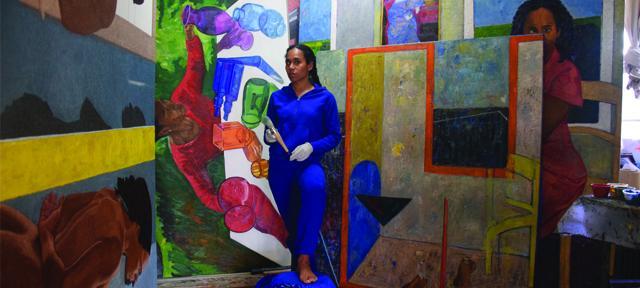Depicted Space


In this photograph I’m standing in my studio, a room downstairs in our house. I constructed this image as source material for a painting not yet made, and which began with me thinking about Velázquez’s Las Meninas.
Enigmatic, Velázquez’s painting depicts members of the Spanish court of King Philip IV and has compelled generations of artists for many reasons — one of which is the complex use of space as a narrative device, withholding and revealing critical information. For example, the way those most central Renaissance figures, king and queen, are posed just beyond the picture, revealed in a mirror.
Las Meninas has me thinking about paintings within paintings, depicted space versus actual space. My interest is also on the princess. Although she is visually centered, many argue that the painting is as much a portrait of Velázquez himself, the master of representation. In Picasso’s many riffs on Las Meninas, he focuses on the artist, whom he presents as king. But I’m thinking about the princess and how she might be cast as artist.
With that in mind, I position myself centrally in royal blue, posed as both model and artist simultaneously. The cascading fabric beneath my raised foot makes a pyramid of my stance. I’m surrounded by my paintings, their maker presented to acknowledge my viewers, not actively painting. Posed commandingly in my blue jogging suit, brush in hand and plastic painting gloves, I’m a parody mashup of the artist as worker and the art model as icon of beauty. The two paintings to my left are closely related to each other. The smaller one in front partially obscures the larger one, but it depicts the underlying structure of the figurative painting behind it.
I, too, aim for mastery. I want to understand deeply the inner workings of pictures. Studying the history of art, I constantly discover painting in its diverse conceptions across time and geography. I get obsessed with little things, like Goya’s calling card clutched in a magpie’s beak and Zurbarán’s cartellino on a painting of the crucifixion. I ask myself a myriad of questions, such as: How can I make paintings that utilize a long view of the medium’s parameters — from Renaissance painting, to folk art, to geometric abstraction? At Hampshire, I gained the open-ended tools of self-education that every artist needs. They are the same intellectual tools I use in the studio each day: articulate my goals, strategize my approach, assess the results . . . and begin again.
MEQUITTA AHUJA is a painter based in Baltimore. Her work has been exhibited across the United States and internationally at the Studio Museum in Harlem, the Museum of Contemporary Art (Chicago), the Museum of Fine Arts (Houston), the National Portrait Gallery, the Baltimore Museum of Art, and the Philadelphia Museum of Art, among others. She holds an MFA from the University of Illinois at Chicago and has received numerous fellowships and awards.
From the Summer 2017 issue of Hampshire's Non Satis Scire magazine.



